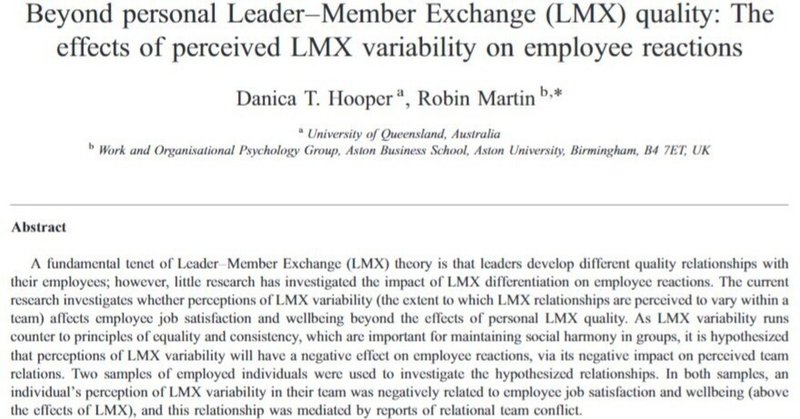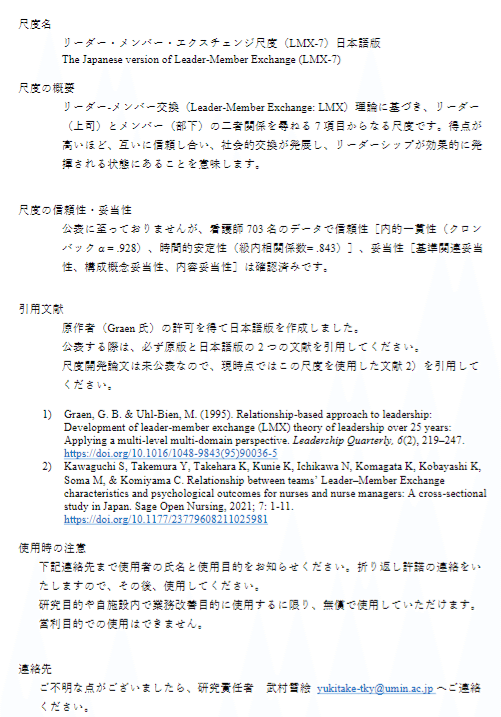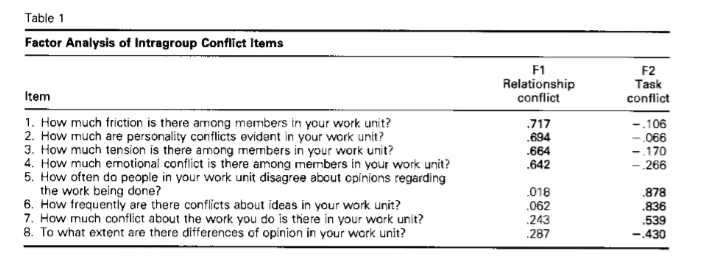
【LMX-variability】Beyond personal Leader–Member Exchange (LMX) quality: Theeffects of perceived LMX variability on employee reactions
概要
リーダーとメンバーの交換(LMX)理論の基本的な考え方は、リーダーが従業員と異なる質の高い関係を築くことにある。しかし、LMXの相違が従業員の反応に及ぼす影響を調査した研究はほとんどない。 本研究は、LMXのばらつきの認識 (LMX 関係がチーム内でどの程度異なると認識されるか) が、個人のLMXの質を超えて、従業員の仕事の満足度と幸福度に及ぼす影響を調べることを目的とした。LMXの変動性variabilityは、グループ内の社会的調和を維持するために重要な平等と一貫性の原則に反するため、LMX の変動性の認識は、チーム関係の認識に悪影響を及ぼし、従業員の反応に悪影響を及ぼすと仮説を立てた。従業員の2サンプルを対象に調査した結果、両サンプルでチーム内の LMXvariabilityの認識は従業員の仕事の満足度や幸福度 (LMXの影響を上回る) と負の関連があり、これはチームの対立により媒介された。
問題と目的
(よい研究なので読みましょう)
LMXが従業員に及ぼす影響
LMXの質が職場における満足度や組織関与及び市民行動に正の影響を及ぼすことは知られている
個別の関係性を超えてチームや組織に及ぼす影響を調べる時期に来ている
LMXは当然ながら個別のフォロワーと異なる質の関係構築がなされることを前提としているが、その質の差が従業員の反応に及ぼす影響は不明確である
リーダーに都合の良いLMX
先行研究によれば、成功しているリーダーは従業員を同じように扱わず、各従業員の要望やモチベーションに応じて扱う (Dansereau, 1995)
特にチームを効率的に運営するために秘書やアシスタントのような数人の従業員を特別に信用してよい関係を形成する可能性がある
理論的なチームにおけるLMXの分散
リーダーにとって節約の可能性があるにもかかわらず、直感的なレベルでは従業員に対する差別的な扱いに問題がある
組織の従業員は比較される情報は、自己概念や公平感に影響を与えるため従業員は過敏になる
よいLMXの従業員は優位になる
LMXの理論的に、よいLMXの従業員はそうではないものより例えば尊敬、信頼、恩義情動、忠誠、プロとしての敬意、情報、影響力、サポート、よいパフォーマンス評価、キャリア形成など有形無形の資源が与えられる
したがって、チーム内でのLMXの質の差はチームメンバーに負の影響を及ぼすと考えられる
しかし実証研究がないため本研究で調査する
文献調査と仮説
LMXの分散によりチームメイトは原因帰属バイアスを生じる (Sias & Jablin, 1995)
同僚がリーダーにより優遇された場合、差別的扱いは不公平で、いい仕事以外の要因だと認識される
同僚への好意的扱いが不公平だと感じられると、メンバー内で嫌悪や不信感を持つ傾向がある
同僚はリーダーによって公平に扱われているものを好む傾向がある (Van Breukelen et al, 2002)
LMXとLMXの分散はインタラクションし、従業員の組織への関与の強さは、LMXが高くかつLMXの分散が小さいチームで高まった (Tyler & Lind, 1992)
同僚が類似したLMXの室にある場合同僚間での交換関係 (cowoker exchange relationship; CWX) が高まる (Sherony & Green, 2002)
競争的な環境は従業員に妬みの感情を生起させ、メンバー内での信頼の欠如や敵意をうむ (Vecchio, 2005)
チームを競争的環境にさせるのはチームの目標を達成できなくさせることはすでにしられている
仕事がチームベースで、協力的(平等な)構造になっている場合、メンバーの協力、対人的魅力、ソーシャルサポート、チームパフォーマンスは向上する (Stanne et al, 1999)
(どういう構造を指しているのか知りたい。看護職のいじめが多い理由を説明しきれないため防止できない)
(医者または看護師長つまり指揮命令系統上看護師の上司にあたる人が不平等なLMXを行っているからと説明されるが、いじめを受けている方たちはそれで説明されたと感じるだろうか
仮説1:個人のLMXの質を統制すると、LMXvariabilityは従業員の満足度やウェルビーイングを抑制する
仮説2:LMXvariabilityと従業員の満足度やウェルビーイングの関連はチーム内葛藤・対立に媒介される(心理学でよくある媒介効果検証は理論的にも因果関係が成立しない要因に適応する例が多いが、これは理論的に疑えない媒介効果検証のためよい参考例となる)
方法
対象者:
2サンプル
サンプルA:74名の従業員 (女性70.3%)
サンプルB:357名のオーストラリアの消防士 (男性97%)
メジャー:
LMX: LMX-7 (Graen & Uhl-Bien, 1995) (See Appendix-A)
Perceived LMX variability (See Appendix-B)(そういうことか、、客観的なLMXvariabilityではなくperceived LMX variability)
Reational Team Conflict (Jehn, 1995) (See Appendix-C)
Job Satisfaction (Warr, 1991)(Warr et al., 1979)
Well-being
結果
Zero-order correlation
LMXは従業員満足度と正の相関がある
LMXとLMX-variabilityは負の相関がある


媒介効果の検証
以下のBaron & Kenny (1986) の媒介効果の4条件を検証する
independent variable must affect the mediator
independent variable must affect the dependent variables
mediator must affect the dependent variables whilst controlling for the independent variables
the relationship between the independent variable and the dependent variables must either reliably reduce or become non-significant when controlling for mediator

サンプルAでは、LMX-variabilityがチーム内の対立・葛藤を通じて仕事の満足度及びウェルビーイングに負の影響を及ぼすことが示されている (重回帰分析によるステップに従う限りにおいて)

サンプルBでは、LMX-variabilityがチーム内の対立・葛藤を通じて外的な仕事の満足度及びウェルビーイングに負の影響を及ぼすことが示されている (重回帰分析によるステップに従う限りにおいて)
考察
文献
Graen, G. B., & Uhl-Bien, M. (1995). Relationship-based approach to leadership: Development of leader-member exchange (LMX) theory of leadership over 25 years: Applying a multi-level multi-domain perspective. Leadership Quarterly, 6, 219−247.
Hooper, D. T., & Martin, R. (2008). Beyond personal leader–member exchange (LMX) quality: The effects of perceived LMX variability on employee reactions. The Leadership Quarterly, 19(1), 20-30.
Jehn, K. A. (1995). A multimethod examination of the benefits and detriments of intragroup conflict. Administrative science quarterly, 256-282.
Sherony, K. M., & Green, S. G. (2002). Coworker exchange: relationships between coworkers, leader-member exchange, and work attitudes. Journal of applied psychology, 87(3), 542.
Sias, P. M., & Jablin, F. M. (1995). Differential superior-subordinate relations, perceptions of fairness, and coworker communication. Human Communication Research, 22(1), 5-38.
Stanne, M. B., Johnson, D. W., & Johnson, R. T. (1999). Does competition enhance or inhibit motor performance: a meta-analysis. Psychological bulletin, 125(1), 133.
Tyler, T. R., & Lind, E. A. (1992). A relational model of authority in groups. Advances in Experimental Social Psychology, 25, 115−191.
Van Breukelen, W. I. M., Konst, D., & Van Der Vlist, R. E. N. E. (2002). Effects of LMX and differential treatment on work unit commitment. Psychological Reports, 91(1), 220-230.
Vecchio, R. (2005). Explorations in employee envy: Feeling envious and feeling envied. Cognition & Emotion, 19(1), 69-81.
Warr, P. B. (1991). Mental health, well-being, and job satisfaction. In B. Hesketh & A. Adams (Eds.), Psychological perspectives on occupational health and rehabilitation (pp. 143−165). London: Harcourt Brace.
Warr, P., Cook, J., & Wall, T. (1979). Scales for the measurement of some work attitudes and aspects of psychological well‐being. Journal of occupational Psychology, 52(2), 129-148.
Appendix-A LMX-7


Appendix-B LMX distribution

Appendix-C Relationship conflict

Appendix-D Job Satisfaction (Warr 1991)
Ratings were made on a 5-point scale ranging from 1 (very unsatisfied) to 5 (very satisfied)
All in all, how satisfied are you with the work itself of your job?
All in all, how satisfied are you with your coworkers?
All in all, how satisfied are you with the supervision?
Appendix-E Job Satisfaction (Warr et al., 1997)
Introduction. The next set of items deals with various aspects of your job. I would like you tell me how satisfied or dissatisfied you feel with each of these features of your present job.
Ratings were made on a 5-point scale ranging from 1 (very unsatisfied) to 5 (very satisfied)
Intrinsic satisfaction (even number)/Extrinsic satisfaction (odds number)
The physical work condition
The freedom to choose your own method of working
Your fellow workers
The recognition you get for good work
Your immediate boss
The amount of responsibility you are given
Your rate of pay
Your opportunity to use your abilities
Industrial relations between management and workers in your firm
Your chance of promotion
The way your firm is managed
The attention paid to suggestions you make
Your hours of work
The amount of variety in your job
Your job security
この記事が気に入ったらサポートをしてみませんか?
